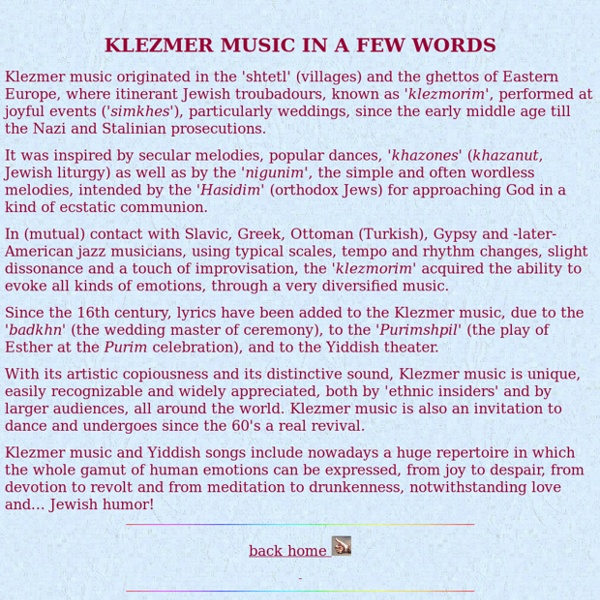What is Jewish Music?
Jewish music stems from ancient prayer chants of the Levant some 3000 years ago. The musical notation that developed and that we find in the bible today is one of the most ancient forms of notated music, and yet it is still in current practice all over the world today. Jewish music has been constantly adapting to new conditions and yet retaining its identity in many widely differing ethnic, social and religious environments. Through its daughter religions, the music of Judaism is one of the fundamental elements in the understanding of the sacred and secular traditions of Europe and the Near East, first having influenced, and then having been influenced by, the music of Christian and Islamic cultures. Ashkenazi Music (Klezmer) Ashkenazi refers to the Jews who settled in the Rhineland of South West Germany and Northern France from about the third century CE. Sephardi Music Israeli Music Synagogue Music Suppressed Music Western Classical Music Sources: Jewish Music Institute
Klezmer fiddle
Klezmer (Yiddish: Klezmer (כליזמר or קלעזמער, pl. כליזמר, כליזמרים, from the Hebrew כלי זמר meaning "vessel of song") is a genre of fiddle music rooted in the medieval shtetl (villages) of Eastern Europe, where wandering Ashkenazi[1] musicians (Klezmorim) played at bar mitzvahs, weddings and holidays (simkhes).[2] ritual of rabbinic Judaism.[3] Influences[edit] Antecedents[edit] Some academic musicologists[4] suggest that ancient Semitic traditions preceded and influenced, along with Tanahk hymns,[5] Greek Pythagorean music. It consisted of a blend of dance tunes, liturgy and meditative chants (nigunim). Medieval[edit] Traditions combined in medieval klezmer include Greek, Turkish, Slavic and later, Jazz. History[edit] Mel Bay music writer Chris Haigh, who himself performs in Klezmer bands, is one of the more prolific and popular writers on the topic, and he makes numerous assertions regarding the history of klezmer music which he does not corroborate with academic references. Horas[edit]
What Instruments Are Played in Klezmer Music?
Klezmer music is a Yiddish folk music that developed during the renaissance in Eastern Europe. The style features mainly acoustic instruments, though modern American takes on the style incorporate drums and vocals into the blueprint, as well. Because of its origins, klezmer is still considered a form of Jewish music, and is frequently heard at Jewish weddings and other functions. Violin The violin sits at the heart of klezmer music. Musicians capitalize on the stringed instrument's highly expressive qualities. Hammered Dulcimer An ancient instrument different from the picked Appalachian dulcimer present in bluegrass sounds, the hammered dulcimer is a large stringed-instrument that musicians play by striking strings with drumstick-like hammers. Accordion Although it's a more recent addition to klezmer music, accordions provide another layer of melodies. Clarinet American klezmer revivalists embraced the clarinet's steadfast sound and octave range as the genre found a home in America. Drums
Celtic Music Instruments
From the thump of the Bodhrán to the airy rasp of the wooden flute, celtic music is known by its instruments. Here's an introduction to the main players, with links to more information, for players and afficionados. Fiddle The fiddle is the mainstay of most Scottish and Irish music. Flute Flutes of one sort or another have been played in the celtic countries for over a thousand years. Tin Whistle (pennywhistle) The simplest and cheapest of traditional instruments, yet not so simple to master. More information: Ceolas Tin Whistle guide. Bagpipes & uilleann pipes Several forms of bagpipe are used in celtic music. The Scottish highland pipes are the loudest, played standing, usually in pipe bands. Bagpipe FAQ Bagpipe Web David Daye's Bagpipe site, for Scottish and uilleann pipes. Bombarde This is a small oboe-like shawm with a penetrating sound, used widely in Breton music. Free reed instruments This family of instruments was developed in the early nineteenth century. Banjo Bouzouki Website.
10 Best Celtic Women Singers | Made Man
It's nearly impossible to single out just 10 best Celtic women singers. Celtic female vocalists are amazing and there are so many good ones. Nevertheless, let's focus on ten of the best. If you're looking to investigate this music, here is a really good starting point. Mary Black Mary Black is the daughter of a fiddler-father and a singer-mother.



